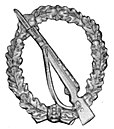Infantry Assault Badge
The infantry assault badge was an award for bravery of the German army in World War II .
Foundation and execution
The badge was introduced on December 20, 1939 by ordinance by the Commander-in-Chief of the Army , Walther von Brauchitsch . According to the Foundation Ordinance, this should be recognized as a visible sign of recognition of the infantryman who has proven himself in the assault, and at the same time as an incentive to fulfill the highest duties .
The artistic designs came from the Berlin company CE Juncker. The badge, made of silver-plated zinc sheet, consisted of a carbine with a saddle rifle attached, which was surrounded by an oval wreath of oak leaves with the national emblem of the Wehrmacht on the upper part .
Award
The infantry assault badge in silver was reserved for officers, non-commissioned officers and men of the rifle companies of non-motorized infantry divisions and mountain infantry companies operating after January 1, 1940
- in three assaults,
- in the front line,
- breaking in with gun in hand,
- Have been involved in three different days of the fight.
Successful violent explorations as well as counter-attacks and counter-attacks were rated as "assaults" if they led to close combat with the enemy. The personal commitment to fighting armored vehicles by lone fighters is also to be assessed as a storm mission (see special badges for fighting armored vehicles by lone fighters ). The winner received a certificate of ownership.
The same provisions applied to the bronze version; it could be awarded to members of the infantry regiments (motorized) as well as the machine gun, infantry artillery and anti-tank companies of the infantry and mountain infantry regiments.
The badge was worn in and out of service on the left side of the chest in accordance with Section B No. 28 of Heeres-Druckvorschrift 122.
Later, the circle of those entitled was expanded to include members of the Waffen SS and the Ordnungspolizei . The General Assault Badge was introduced a little later for members of other units . The tank troops had the comparable tank battle badge .
Carrying method
The award was worn as a pin badge on the left breast pocket.
Others
According to the law on titles, medals and decorations of July 26, 1957, wearing the award in Germany is only permitted without National Socialist emblems.
literature
- Kurt-Gerhard Klietmann : Awards of the German Empire. 1936-1945. Motorbuch, Stuttgart 2002, ISBN 3-87943-689-4 .



